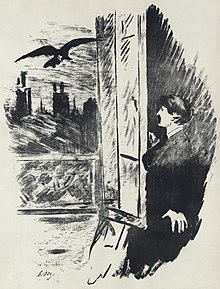
Back قصيدة الغراب Arabic Крумкач (верш) Byelorussian Крумкач (верш) BE-X-OLD Гарванът (стихотворение) Bulgarian Gavran (Edgar Allan Poe) BS El corb (poema) Catalan قەلەڕەش (شیعر) CKB U corbu (Edgar Poe) Corsican Havran (báseň) Czech Ravnen (digt) Danish

"The Raven" is a narrative poem by American writer Edgar Allan Poe. First published in January 1845, the poem is often noted for its musicality, stylized language, and supernatural atmosphere. It tells of a distraught lover who is paid a mysterious visit by a talking raven. The lover, often identified as a student,[1][2] is lamenting the loss of his love, Lenore. Sitting on a bust of Pallas, the raven seems to further antagonize the protagonist with its constant repetition of the word "Nevermore". The poem makes use of folk, mythological, religious, and classical references.
Poe claimed to have written the poem logically and methodically, with the intention to create a poem that would appeal to both critical and popular tastes, as he explained in his 1846 follow-up essay, "The Philosophy of Composition". The poem was inspired in part by a talking raven in the novel Barnaby Rudge: A Tale of the Riots of Eighty by Charles Dickens.[3] Poe based the complex rhythm and meter on Elizabeth Barrett's poem "Lady Geraldine's Courtship", and made use of internal rhyme as well as alliteration throughout.
"The Raven" was first attributed to Poe in print in the New York Evening Mirror on January 29, 1845. Its publication made Poe popular in his lifetime, although it did not bring him much financial success. The poem was soon reprinted, parodied, and illustrated. Critical opinion is divided as to the poem's literary status, but it nevertheless remains one of the most famous poems ever written.[4]
